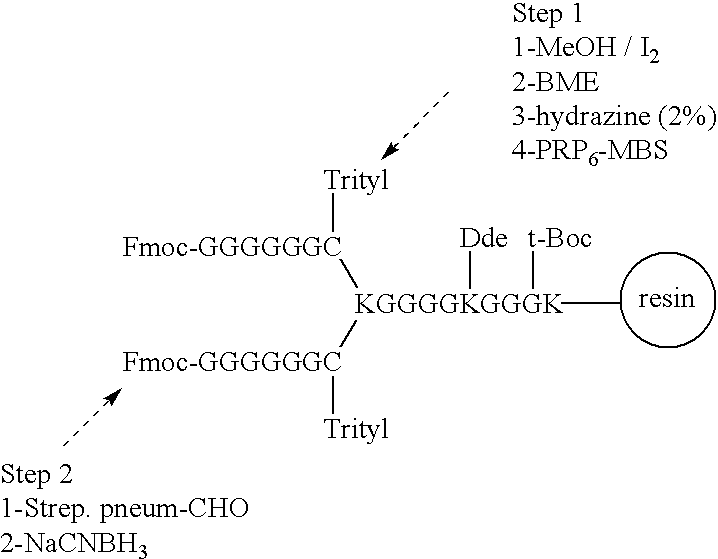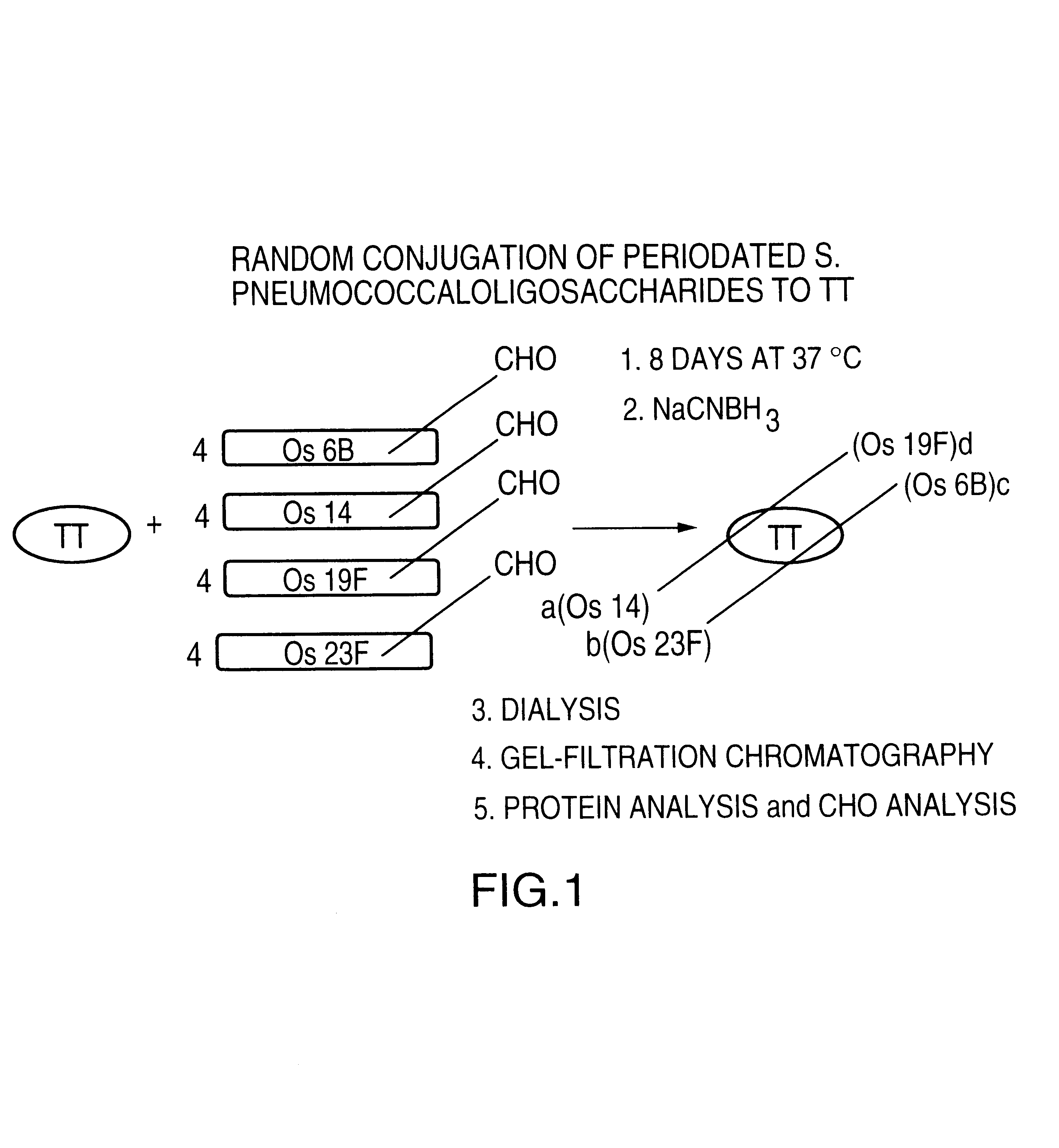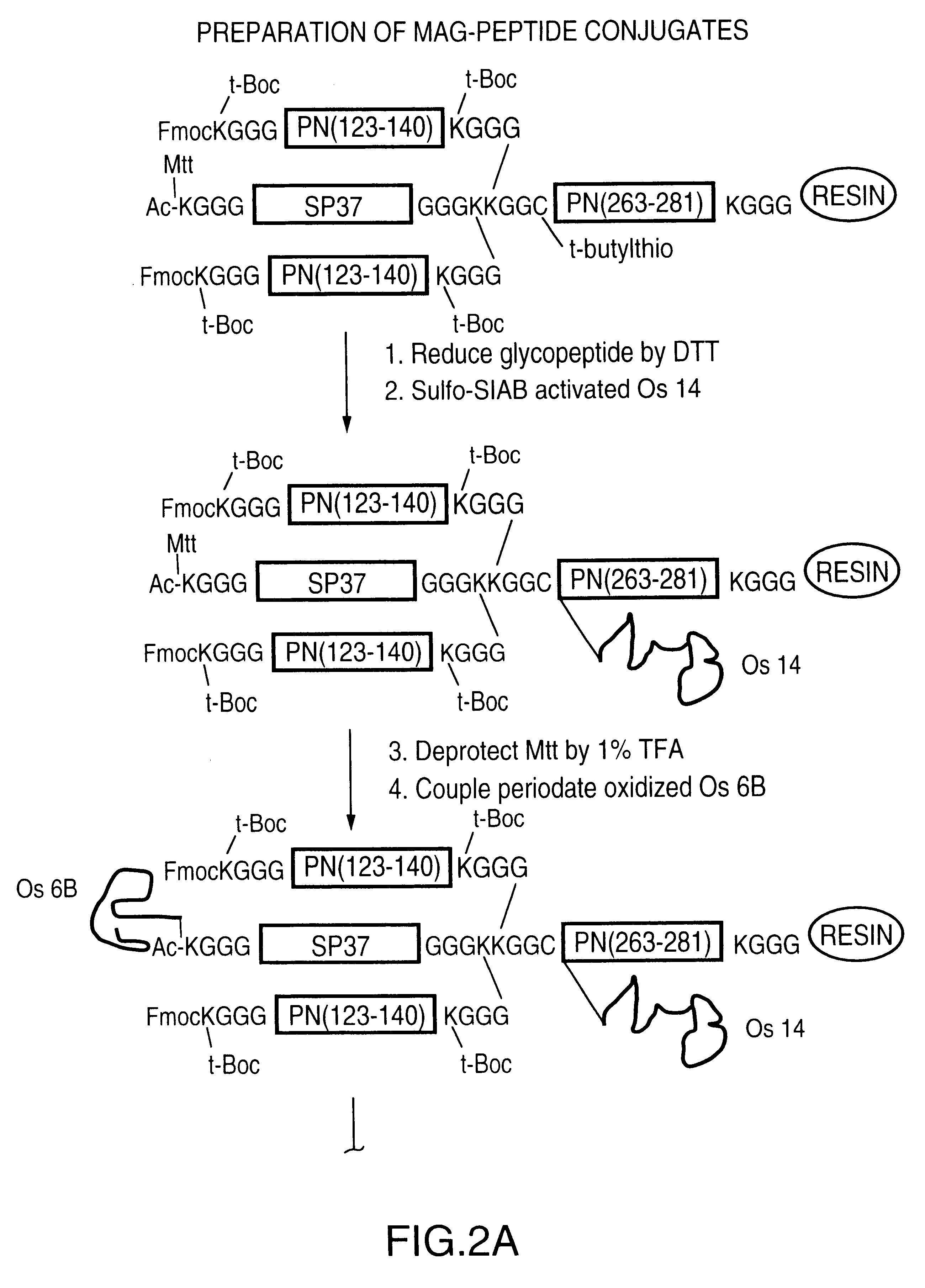Multi oligosaccharide glycoconjugate bacterial meningitis vaccines
a technology of oligosaccharide and vaccine, which is applied in the direction of bacterial antigen ingredients, saccharide peptide ingredients, non-active ingredients of pharmaceuticals, etc., can solve the problems of short antibody response and limited by the number of responsive b-cells, and achieve the effect of strengthening the host immune response against hepatitis b virus
- Summary
- Abstract
- Description
- Claims
- Application Information
AI Technical Summary
Benefits of technology
Problems solved by technology
Method used
Image
Examples
example 1
This Example shows the preparation of acid-hydrolyzed group B meningococcal (GBM) oligosaccharides.
This Example describes a method for preparing GBM oligosaccharides (M. wt. 3000 to 4500 Da) from the commercially available GBM polysaccharides (M. wt>10 KDa).
Reagents required:
1--GBM polysaccharides from Sigma cat#C-5762.
2--Sodium acetate (50 mM) buffer pH 5.00, prepared by mixing one volume of 0.5 M sodium acetate with one volume of 0.23M acetic acid.
3--Reaction vial and a magnetic stirring bar.
4--Sephadex G-25 gel column
5--Ammonium bicarbonate (20 mM)
Procedure:
The GBM polysaccharide (200 mg) was dissolved in 15 mL of degassed 50 mM sodium acetate buffer, pH 5.0 and the mixture was then stirred at 80.degree. C. for 1 hr. The reaction mixture was then immediately cooled with ice and neutralized to pH 7.0 by dropwise addition of 0.1M NaOH. The total mixture was then lyophilized to yield a crude product (460 mg, containing sodium acetate). About 100 mg acid treated GBM were first dissol...
example 2
This Example shows chemical modification of acid-hydrolyzed GBM oligosaccharides.
N-propionylated, acid-hydrolyzed GBM oligosaccharides were prepared according to the method previously described by H. Jennings et al. (ref. 6) with some modifications. The N-propionylated GBM oligosaccharides ultimately were coupled to a MAP backbone containing other oligosaccharide to produce multivalent multiple carbohydrate vaccines, as described below.
Reagents required:
1--Acid-hydrolyzed GBM oligosaccharides.
2--Sodium hydroxide (2 M solution).
3--Propionic anhydride (Aldrich).
4--Ammonium bicarbonate (10 mM)
5--Aqueous oxalic acid (50%)
6--Sodium borohydride (Sigma)
Procedure:
N-deacetylated acid-hydrolyzed group B meningococcal polysaccharides were prepared according to the method described by Jenning et al., with three modifications;
1--The reaction was performed at ca 110.degree. to 120.degree. C.
2--The dialysis was performed using molecular porous membrane (1000 mol. wt. cut off).
3--The neutralization...
example 3
This Example shows the preparation of Oligosaccharides from Streptococcus Pneumoniae
This Example describes the general methods using acid hydrolysis of Streptococcus pneumoniae capsular polysaccharides (CF) (M. wt approximately 50 kDa) to produce oligosaccharides with a molecular mass ranging from 2.5 to 5.0 kDa. The resulting oligosaccharides can be subjected to a novel glycoconjugation technology to prepare glycoconjugates containing multiple-oligosaccharides covalently linked to a carrier protein or a multiple antigen peptide system (MAP).
Reagents required:
1--CP serotypes 6B, 14, 19F and 23F (ATTC)
2--Acetic acid
3--Trifloroacetic acid
4--Gel chromatography column (Sephadex G-100, 10.times.1000 mm)
5--Round bottom flask (250 mL)
6--Magnetic stirring bar
7--Oil bath
Procedure:
In a round bottom flask, the CPs (see Table 4 below) was dissolved in warm degassed water (62.5 mL) followed by the addition of the required amount of degassed acid (see Table 4 below). The total mixture was degasse...
PUM
| Property | Measurement | Unit |
|---|---|---|
| molecular weights | aaaaa | aaaaa |
| molecular weights | aaaaa | aaaaa |
| mean mass | aaaaa | aaaaa |
Abstract
Description
Claims
Application Information
 Login to View More
Login to View More - R&D
- Intellectual Property
- Life Sciences
- Materials
- Tech Scout
- Unparalleled Data Quality
- Higher Quality Content
- 60% Fewer Hallucinations
Browse by: Latest US Patents, China's latest patents, Technical Efficacy Thesaurus, Application Domain, Technology Topic, Popular Technical Reports.
© 2025 PatSnap. All rights reserved.Legal|Privacy policy|Modern Slavery Act Transparency Statement|Sitemap|About US| Contact US: help@patsnap.com



